RCA Radiomarine ET-8044 marine radiotelephone
 Radios
of
this type served multiple purposes. The crystal controlled transceiver
could be used ship-to-ship, ship-to-shore, and ship-to-telephone
service. With a land telephone account, boaters could make calls to a
special marine operator, and place calls to regular telephones. A
fourth crystal frequency was usually chosen as a local weather service.
In addition, this radio receives standard AM broadcast.
Radios
of
this type served multiple purposes. The crystal controlled transceiver
could be used ship-to-ship, ship-to-shore, and ship-to-telephone
service. With a land telephone account, boaters could make calls to a
special marine operator, and place calls to regular telephones. A
fourth crystal frequency was usually chosen as a local weather service.
In addition, this radio receives standard AM broadcast.
I was hoping to find one of these radios, the precurser to VHF marine
radiocommunications, for some time. I was surprised to see this one on
eBay with a starting bid of only $9.99, and even more surprised that no
one else bid on it. In the year or so since I got it, I haven't seen
but three or four other marine band crystal controlled radiotelephones,
and no other Radiomarine models.
This one is from somewhere between 1949 to 1954. I'm not sure how long
they produced them, and they may have ended the model before '54. I got
it
without it's "Magic-Eye"
tuning signal tube, or it's two 6V6 vacuum tubes... but these were easy
to find. The RCA logo on the image above is simply a paper one I
printed out. I intend on making or finding a correct logo badge. The
unit is very grimy. You can see part of the front cleaned up. The paint
is scratched and chipped. I've cleaned and sanded the case, and painted
it with hammered finish paint. The original paint was just
too far gone to keep.
 Although
the cabinet finish is in poor shape, the chassis and components appear
(at least) to be fairly intact. I have not tried to fire up the unit
yet. I still have to find a proper bakelite microphone for it. But it
did come with crystals for 2390KC, 2638KC, 2670KC and 2738KC. The
last was the frequency for the Gulf of Mexico's Swan Island station
WSG... but after learning more about marine radio frequencies in this
range, I found that 2738 was actually designated as ship-to-ship. This
is the more likely reason 2738 is included here. Interestingly this
radio does not include 2182, which was and is the "call and distress"
frequency. Perhaps it was not yet designated as such in 1949.
Although
the cabinet finish is in poor shape, the chassis and components appear
(at least) to be fairly intact. I have not tried to fire up the unit
yet. I still have to find a proper bakelite microphone for it. But it
did come with crystals for 2390KC, 2638KC, 2670KC and 2738KC. The
last was the frequency for the Gulf of Mexico's Swan Island station
WSG... but after learning more about marine radio frequencies in this
range, I found that 2738 was actually designated as ship-to-ship. This
is the more likely reason 2738 is included here. Interestingly this
radio does not include 2182, which was and is the "call and distress"
frequency. Perhaps it was not yet designated as such in 1949.

Here an ad for the unit, from a 1949 issue of Yachting Magazine. The
$197.50 would be something like $2,000 in today's dollars... so we are
talking a major investment. But to have a unit like this was nothing
short of miraculous at the time. I've seen marine band radiotelephones
hawked as safety devices, business tools, and fisherman's friends.
Unfortunately the image was re-touched so extensively for this ad that
the original mic bracket was obliterated... and I need to make one from
scratch! A little guess-work will be involved there... Click for larger
image.

And another ad, with customer feedback...
 The
face removed from the radio. The brushed aluminum edge detail is
pitted in spots, and oxidized in others. I wanted to re-brush it, but
needed to protect the paint. At first I thought I would not repaint the
front, at least until
I figured out how they silk-screened so perfectly to the raised
lettering and detail. I actually silk-screened control panels for
electronic devices (power supplies for US contract experimental laser
weapons and fusion research) back in the early eighties. But this is
different... the paint comes perfectly to the edges of all raised
details.
The
face removed from the radio. The brushed aluminum edge detail is
pitted in spots, and oxidized in others. I wanted to re-brush it, but
needed to protect the paint. At first I thought I would not repaint the
front, at least until
I figured out how they silk-screened so perfectly to the raised
lettering and detail. I actually silk-screened control panels for
electronic devices (power supplies for US contract experimental laser
weapons and fusion research) back in the early eighties. But this is
different... the paint comes perfectly to the edges of all raised
details.
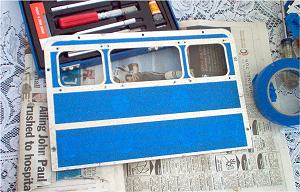
At first I had masked the paint off to protect it. I
experimented with a small brass brush in a Dremel tool, which mimics
the original aluminum finish closely, and removes the oxidation. Then I
tried to
bring the existing paint back as well as I can by using automotive car
cleaner and polish. As you will see below, this process was not enough
to save the panel paint. It was just too far gone.
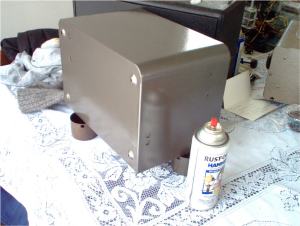
Here is the cabinet painted with Rustoleum
hammertone "dark
bronze". The color is not quite as brown as the original, but it is
close to the hammertone on the front panel. The next closest paint was
the Hammertone brand's color "brown". But it was very brown, and closer
to the RCA's hammertone used on thier RDF's of the time.

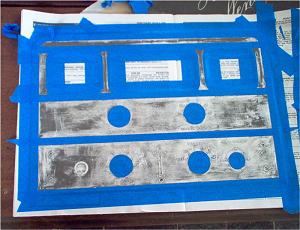

The "can of worms" opened: I needed to strip it all once I decided to
re-paint the panel. My main worry was that I would not be able to
properly expose the raised
aluminum lettering. But I tested several of the letters by priming,
painting and scraping them off... it turned out that with a small
X-acto blade, when the paint was still soft and pliable, I could gently
remove the paint over the letters. So I masked off the main aluminum
areas, primed and painted over the rest, then scraped all the lettering
clean.
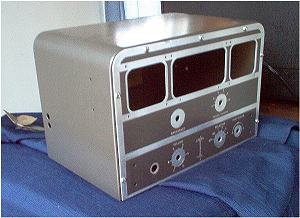
The panel fitted back on, temporarily, after painting and "lettering
stripping". The exposed aluminum is still pitted, and my brushing and
steel wool treatment of it could not make that go away. I thought about
filling the pitting with aluminum solder, but it is a different color
anyway, and would have looked "blotchy". So for now, the brushed areas
will just have to live with some pits.
The screws are phillips pan-head, s/s #8 x 1". Stainless is a bit
duller than the original chromed screws on the face, but I had none of
these outside panel screws with the radio when I got it.
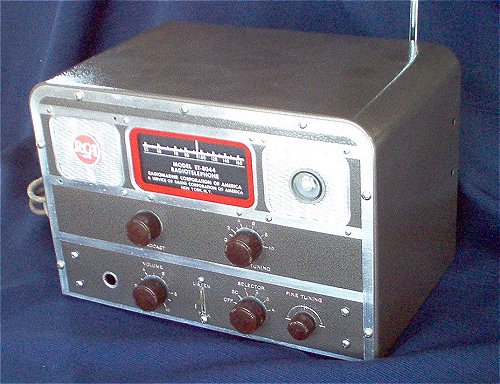
Here the radio is almost finished, cosmetically. I cleaned the
chassis, too, as well as I could without disassembling it. I still need
to find the proper enamaled RCA badge, the proper mic, and I need to
make a microphone bracket. I also confess I misplaced the "talk"
button... just hoping the cats knocked it off the table, and under the
couch or something. The possibility it got vacuumed I don't want to
think about. The antenna is not original... it came with the unit, but
was installed years ago by someone who wanted to make the unit more
portable. Perhaps they were using it as a countertop AM radio...
because the antenna was not hooked up to the transmit lead. It seems to
be a late 40's to 50's automotive AM antenna. But rather than fill the
holes, I put it back for now. Not authentic, but useful for testing the
radio when I try to fire it up. Click on the image for a larger one.

To the left is the Radiomarine AR-8711 radio direction finder,
which is the sister unit to the ET-8044. I have a picture of them
together on the "sister set" page.

 Radios
of
this type served multiple purposes. The crystal controlled transceiver
could be used ship-to-ship, ship-to-shore, and ship-to-telephone
service. With a land telephone account, boaters could make calls to a
special marine operator, and place calls to regular telephones. A
fourth crystal frequency was usually chosen as a local weather service.
In addition, this radio receives standard AM broadcast.
Radios
of
this type served multiple purposes. The crystal controlled transceiver
could be used ship-to-ship, ship-to-shore, and ship-to-telephone
service. With a land telephone account, boaters could make calls to a
special marine operator, and place calls to regular telephones. A
fourth crystal frequency was usually chosen as a local weather service.
In addition, this radio receives standard AM broadcast. Although
the cabinet finish is in poor shape, the chassis and components appear
(at least) to be fairly intact. I have not tried to fire up the unit
yet. I still have to find a proper bakelite microphone for it. But it
did come with crystals for 2390KC, 2638KC, 2670KC and 2738KC. The
last was the frequency for the Gulf of Mexico's Swan Island station
WSG... but after learning more about marine radio frequencies in this
range, I found that 2738 was actually designated as ship-to-ship. This
is the more likely reason 2738 is included here. Interestingly this
radio does not include 2182, which was and is the "call and distress"
frequency. Perhaps it was not yet designated as such in 1949.
Although
the cabinet finish is in poor shape, the chassis and components appear
(at least) to be fairly intact. I have not tried to fire up the unit
yet. I still have to find a proper bakelite microphone for it. But it
did come with crystals for 2390KC, 2638KC, 2670KC and 2738KC. The
last was the frequency for the Gulf of Mexico's Swan Island station
WSG... but after learning more about marine radio frequencies in this
range, I found that 2738 was actually designated as ship-to-ship. This
is the more likely reason 2738 is included here. Interestingly this
radio does not include 2182, which was and is the "call and distress"
frequency. Perhaps it was not yet designated as such in 1949.

 The
face removed from the radio. The brushed aluminum edge detail is
pitted in spots, and oxidized in others. I wanted to re-brush it, but
needed to protect the paint. At first I thought I would not repaint the
front, at least until
I figured out how they silk-screened so perfectly to the raised
lettering and detail. I actually silk-screened control panels for
electronic devices (power supplies for US contract experimental laser
weapons and fusion research) back in the early eighties. But this is
different... the paint comes perfectly to the edges of all raised
details.
The
face removed from the radio. The brushed aluminum edge detail is
pitted in spots, and oxidized in others. I wanted to re-brush it, but
needed to protect the paint. At first I thought I would not repaint the
front, at least until
I figured out how they silk-screened so perfectly to the raised
lettering and detail. I actually silk-screened control panels for
electronic devices (power supplies for US contract experimental laser
weapons and fusion research) back in the early eighties. But this is
different... the paint comes perfectly to the edges of all raised
details. 







